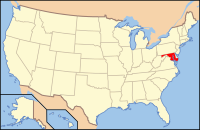St. Mary's County, Maryland
| Saint Mary's County, Maryland | ||
|---|---|---|
|
||
 Location in the U.S. state of Maryland |
||
 Maryland's location in the U.S. |
||
| Founded | January 24, 1637 | |
| Named for | Mary the mother of Jesus | |
| Seat | Leonardtown | |
| Largest community | California | |
| Area | ||
| • Total | 764 sq mi (1,979 km2) | |
| • Land | 357 sq mi (925 km2) | |
| • Water | 407 sq mi (1,054 km2), 53% | |
| Population (est.) | ||
| • (2015) | 111,413 | |
| • Density | 146/sq mi (56/km²) | |
| Congressional district | 5th | |
| Time zone | Eastern: UTC-5/-4 | |
| Website | www |
|
Saint Mary's County (often abbreviated as St. Mary's County), established in 1637, is a county located in the U.S. state of Maryland. As of the 2010 census, the population was 105,151. Its county seat is Leonardtown. The name is in honor of the Catholic saint Mary, the mother of Jesus as told in the Bible.
St. Mary's County comprises the California-Lexington Park, MD Metropolitan Statistical Area, which is also included in the Washington-Baltimore-Arlington, DC-MD-VA-WV-PA Combined Statistical Area. It is part of the Southern Maryland region. The county was the home to the first Maryland Colony, and the first capitol of the Colony of Maryland. Settled by English Catholics, it is considered to be the birthplace of religious freedom in North America, at a time when the British colonies were settled primarily by Protestants.
It is also home to the Patuxent River Naval Air Station and also St. Mary's College of Maryland.
St. Mary's County has been traditionally known for its unique and historic culture of Chesapeake Bay tidewater farming, fishing and crabbing communities. But with the advent of the military bases, growth of an extensive defense contractor presence and the growth of St. Mary's College of Maryland, as well as increasing numbers of long-distance Washington D.C. commuters, it has been undergoing a decades-long transformation which has seen the county's population doubled since 1970.
...
Wikipedia

